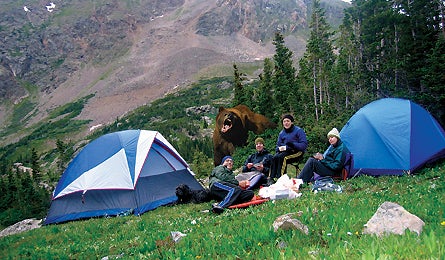Never Fear: The Fix

'Photo illustration by Stephen Beneski'
In the Head | In the Field | The Moment of Truth | Follow Up
In the Head
Step one is arming yourself with knowledge about your fear. A solid foundation of facts gives you a realistic outlook—a powerful weapon to combat anxiety.
- Get the facts Check out the real probability that you’d suffer your nightmare fate (see “The Phobias,”). Just knowing how low the odds of danger are will put panic in perspective.
- Become an expert We fear what we don’t understand, so find out what black bears eat (not humans), what a tarantula would do if you met one on the trail (crawl away), and when and where to expect lightning (summer afternoons above treeline).
- Get schooled Preparation is a potent antidote for fear; learn basic backcountry skills such as map and compass navigation, first aid, bear-safety protocol, and emergency firestarting. If you’re heading into more advanced territory, pick up next-level skills such as river crossing and self-arrest, then practice the techniques until they’re second nature.
- Have a plan “Knowledge is power. It gives you control,” says Ross. Identify your worst-case scenario: Charged by a grizzly? Learn exactly how to respond. Check backpacker.com/skills/survival for tips on this and other frightening situations.
In the Head | In the Field | The Moment of Truth | Follow Up
In the Field
Learning is essential, but it’s not enough. “You can’t read yourself out of a phobia,” says Page Anderson, assistant professor of psychology at the University of Georgia. When you come into contact with your feared object over and over, and no catastrophes ensue, your brain will get used to it—and your body will stop reacting with panic.
- Build a hierarchy Make a list of situations and rate how much each scares you on a scale of 1 to 100. Put them in ascending order from least to most frightening. See this sample fear hierarchy for grizzly bears:
1. Looking at pictures of bears (10)
2. Watching videos of calm bears in a natural setting (15)
3. Watching videos of aggressive, growling bears (20)
4. Imagining encountering a bear on the trail (35)
5. Seeing a bear at the zoo (40)
6. Standing close to a bear at the zoo (50)
7. Driving around Yellowstone National Park (70)
8. Watching a bear in the park from the car (75)
9. Dayhiking with a group in Yellowstone (85)
10. Dayhiking alone in Yellowstone (95)
11. Camping in a Yellowstone frontcountry campground (98)
12. Camping in the Yellowstone backcountry (100)
- Work up the ladder Starting with the least-scary item on your list, put yourself in each of the situations and—this is key—stick with it until your anxiety fades. “Allow the fear to come and pass,” says Todd Farchione, assistant research professor at the Boston University Center for Anxiety and Related Disorders. Repeat each step as necessary before moving. An experienced friend or guide can help.
In the Head | In the Field | The Moment of Truth | Follow Up
The Moment of Truth
Don’t let the scariest scenarios on your fear hierarchy become paralyzing. Here’s how to handle the most frightening steps on the ladder.
- Prepare yourself Expect to be scared. Anticipate the way your body will feel, then remind yourself that it’s okay—the fear will pass.
- Ditch the crutches Sedatives, a shot of whiskey, carrying a big stick in case you meet a bear—these things might calm your nerves temporarily, but they’re just Band-Aid solutions.
- Go ahead and freak Don’t try to force yourself to relax. To truly overcome, you have to learn that feeling scared doesn’t mean you’re in real danger.
- Don’t forget to breathe Close your eyes, exhale slowly, and hold your breath for a moment. Inhale through your nose. Repeat 15 times. This slows your heart rate and prevents hyperventilation.
- Focus on the moment Pay attention to your body and your immediate surroundings. When you concentrate on what’s really happening—raindrops pounding your tent, the ledge you’re standing on—you stop obsessing about the worst-case scenario.
In the Head | In the Field | The Moment of Truth | Follow Up
Follow Up
Beating fear is like losing weight: To keep up the progress, you can’t go back to your old habits. Continue to expose yourself to the situations that once scared you—whether that means an annual trip to Glacier or just keeping a grizzly photo taped to your fridge.